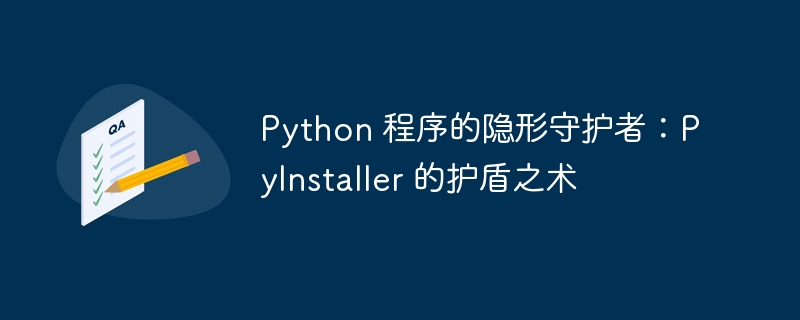Home >Backend Development >Python Tutorial >The invisible guardian of Python programs: the shielding technique of PyInstaller
The invisible guardian of Python programs: the shielding technique of PyInstaller
- WBOYWBOYWBOYWBOYWBOYWBOYWBOYWBOYWBOYWBOYWBOYWBOYWBforward
- 2024-02-19 23:18:131109browse

PyInstaller: python The invisible guardian of the program
PyInstaller is an essential tool that allows you to convert Python scripts into standalone executable files, eliminating dependence on the Python interpreter. It provides the following main advantages:
Cross-platform compatibility
PyInstaller creates executables for windows, MacOS and linux systems, allowing your applications to be easily deployed across multiple platforms.
Protect source code
PyInstaller compiles Python source code into bytecode when packaging an executable file, preventing others from viewing or modifying your code.
Operate independently
The packaged executable file can run independently without installing a Python interpreter, simplifying application deployment and distribution.
Use PyInstaller to package Python scripts
Packaging Python scripts using PyInstaller is very simple. Just follow these steps:
- Install PyInstaller:
pip install pyinstaller - Navigate to the directory containing the Python script.
- Run the following command:
pyinstaller -F myscript.py, wheremyscript.pyis the name of the script you want to package.
PyInstaller will create a dist directory containing the executable and required dependencies.
Example Demonstration
Let’s demonstrate how to package a simple Python script using PyInstaller:
# myscript.py
print("Hello, world!")
Use PyInstaller to package the script:
pyinstaller -F myscript.py
PyInstaller will generate an executable file myscript.exe that you can run directly to print "Hello, world!".
PyInstaller Advanced Options
PyInstaller provides a variety of advanced options for customizing the packaging process, such as:
- --onefile: Pack all files into one executable file.
- --hidden-import: Import modules that are not explicitly declared.
- --windowed: Create an executable file with a graphical interface.
- --add-data: Attach data files to the executable package.
For details on advanced options, see the PyInstaller documentation.
in conclusion
PyInstaller is a powerful Python program packaging tool that provides your applications with protection, cross-platform compatibility, and the ability to run independently. By using PyInstaller, you can easily convert Python scripts into user-friendly executable files, improving your projectdevelopment experience. Mastering the capabilities of PyInstaller will give you significant advantages in Python Programming.
The above is the detailed content of The invisible guardian of Python programs: the shielding technique of PyInstaller. For more information, please follow other related articles on the PHP Chinese website!
Related articles
See more- How to package a Python script into an executable file? (detailed)
- python package exe executable file
- How to convert list to string in python
- How to clear protection history in Windows 11: 2 methods
- How to solve the problem that after the vue3 project is packaged and published to the server, the access page displays blank

